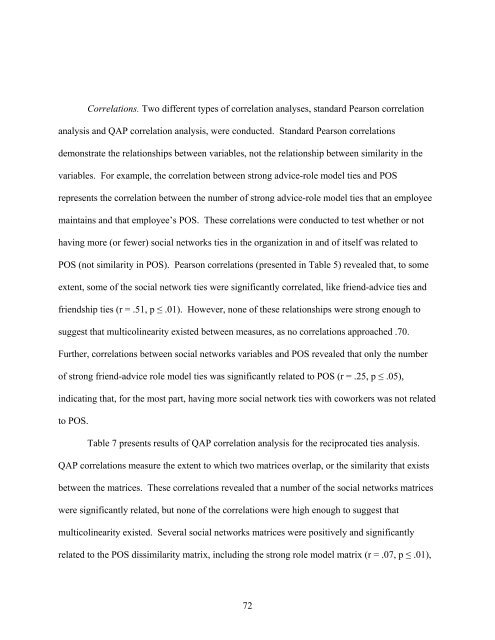a social influence analysis of perceived organizational support
a social influence analysis of perceived organizational support
a social influence analysis of perceived organizational support
You also want an ePaper? Increase the reach of your titles
YUMPU automatically turns print PDFs into web optimized ePapers that Google loves.
Correlations. Two different types <strong>of</strong> correlation analyses, standard Pearson correlation<br />
<strong>analysis</strong> and QAP correlation <strong>analysis</strong>, were conducted. Standard Pearson correlations<br />
demonstrate the relationships between variables, not the relationship between similarity in the<br />
variables. For example, the correlation between strong advice-role model ties and POS<br />
represents the correlation between the number <strong>of</strong> strong advice-role model ties that an employee<br />
maintains and that employee’s POS. These correlations were conducted to test whether or not<br />
having more (or fewer) <strong>social</strong> networks ties in the organization in and <strong>of</strong> itself was related to<br />
POS (not similarity in POS). Pearson correlations (presented in Table 5) revealed that, to some<br />
extent, some <strong>of</strong> the <strong>social</strong> network ties were significantly correlated, like friend-advice ties and<br />
friendship ties (r = .51, p ≤ .01). However, none <strong>of</strong> these relationships were strong enough to<br />
suggest that multicolinearity existed between measures, as no correlations approached .70.<br />
Further, correlations between <strong>social</strong> networks variables and POS revealed that only the number<br />
<strong>of</strong> strong friend-advice role model ties was significantly related to POS (r = .25, p ≤ .05),<br />
indicating that, for the most part, having more <strong>social</strong> network ties with coworkers was not related<br />
to POS.<br />
Table 7 presents results <strong>of</strong> QAP correlation <strong>analysis</strong> for the reciprocated ties <strong>analysis</strong>.<br />
QAP correlations measure the extent to which two matrices overlap, or the similarity that exists<br />
between the matrices. These correlations revealed that a number <strong>of</strong> the <strong>social</strong> networks matrices<br />
were significantly related, but none <strong>of</strong> the correlations were high enough to suggest that<br />
multicolinearity existed. Several <strong>social</strong> networks matrices were positively and significantly<br />
related to the POS dissimilarity matrix, including the strong role model matrix (r = .07, p ≤ .01),<br />
72
















